Exterior Veneer Settings
With the Exterior Veneer Settings command, the current exterior veneer type, height, material, unit dimensions settings can be accessed.
Location of the Exterior Veneer Settings Command
You can access it under the Ribbon menu, Facade tab, Exterior Facade title.
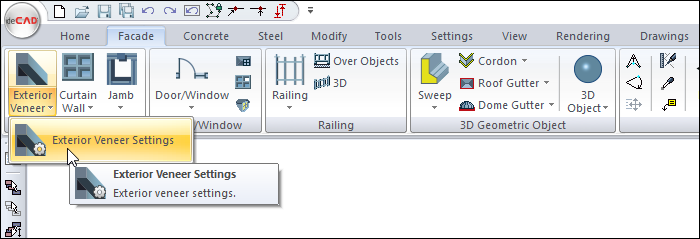
General Tab
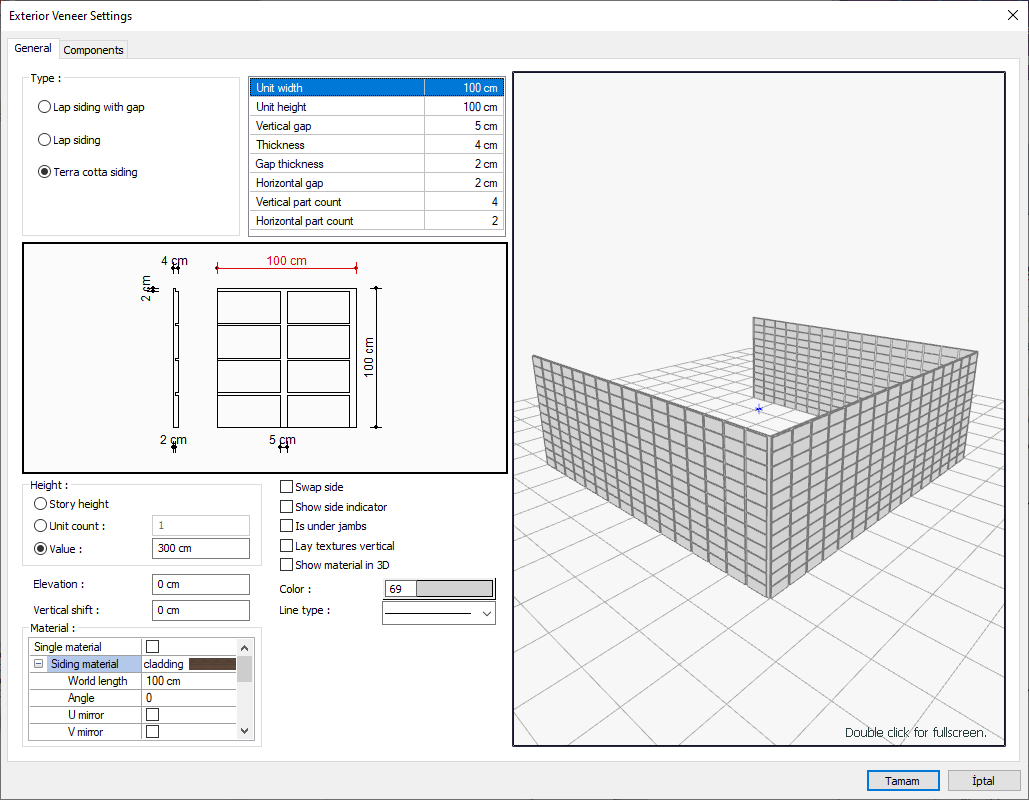
Specifications |
|---|
Type 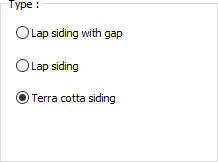 As the exterior veneer, one of the lap siding with gap, lap siding or terra cotta siding types is selected. After the selection is made, the dimensions for the selected type are set in the table on the right. |
Unit dimensions  Give the dimensions of the exterior veneer unit element according to the references shown in the figure. While giving the dimensions, you can follow the change of the shape according to the entered dimensions from the front view below. Clicked size line is displayed in red in the preview. |
Schematic drawing 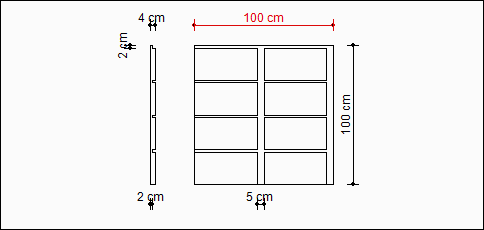 Schematic drawings and dimensions of the unit belonging to the selected type are given. |
Story height  It is drawn in the height value as much as the floor height value given in the floor general settings dialog. |
Unit count  It is drawn in the height value as much as the given number of elements. The element height can be given as the unit height just above. |
Value  It is drawn in height value as much as the entered value. |
Elevation  It is the elevation value of the siding object relative to the story floor. Depending on the negative or positive value, the object is shifted up or down. |
Vertical shift  It is the value that shifts the veneer piece up and down. For example, the veneer is defined on the 1st story and 2nd story. If there is not as much distance as the veneer piece between the 1st story and the 2nd story, the exterior veneer pieces can be proportional to the vertical shift. |
Swap side  It takes the symmetry of the exterior veneer. |
Show side indicator  In the plan drawing of the siding element, an arrow is shown indicating where the outeside is. This option determines whether that arrow is drawn in the plan. |
Is under jamb  It extends the exterior veneer element under the jamb element, up to the window/door gap. If not marked, finish the exterior element at the edge of the jamb, surrounding the jamb. |
Lay textures vertical  The coating texture assigned to the exterior element is placed perpendicular to the element surface. Otherwise, it is placed horizontally. |
Show material in 3D  The 3 dimensional view shown on the right in the dialog is shown with the textures assigned to the exterior element. If not marked, the 3D image element appears painted with its own color. |
Color  The siding is the color of the element. The desired color is selected from the color box. |
Line type  It is the line type of the exterior veneer element visible in the plan. The desired line type is selected from the list. |
Material  The material to be used on the siding and gap is selected from the list. Surfaces are covered with the selected material and displayed as such in renderings. Texture length is entered into the world length. For example; If 1 is entered, the selected material texture is taken as 1 meter and covered on the relevant walls. In the angle, the angle of the texture is entered. Touch the U and V offset. The motion value in the x and y plane is entered. With U and V mirroring, the texture is symmetrical with respect to the y and x planes. By selecting the single material option, the material selected in "Siding material" is used on all surfaces of the exterior veneer. |
3D preview 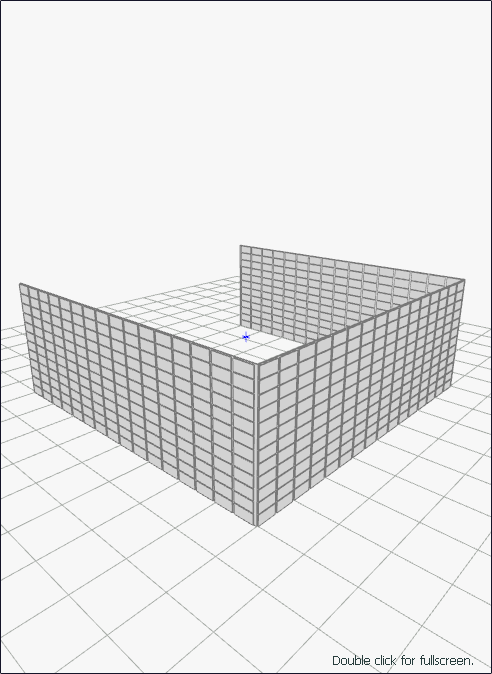 It is the front view of the siding. The image will also change in accordance with the type of coating selected on the top. The dimensions for the respective facade covering are also shown in the image. Dimensions for the selected type can be set in the table above the image. |
Components Tab
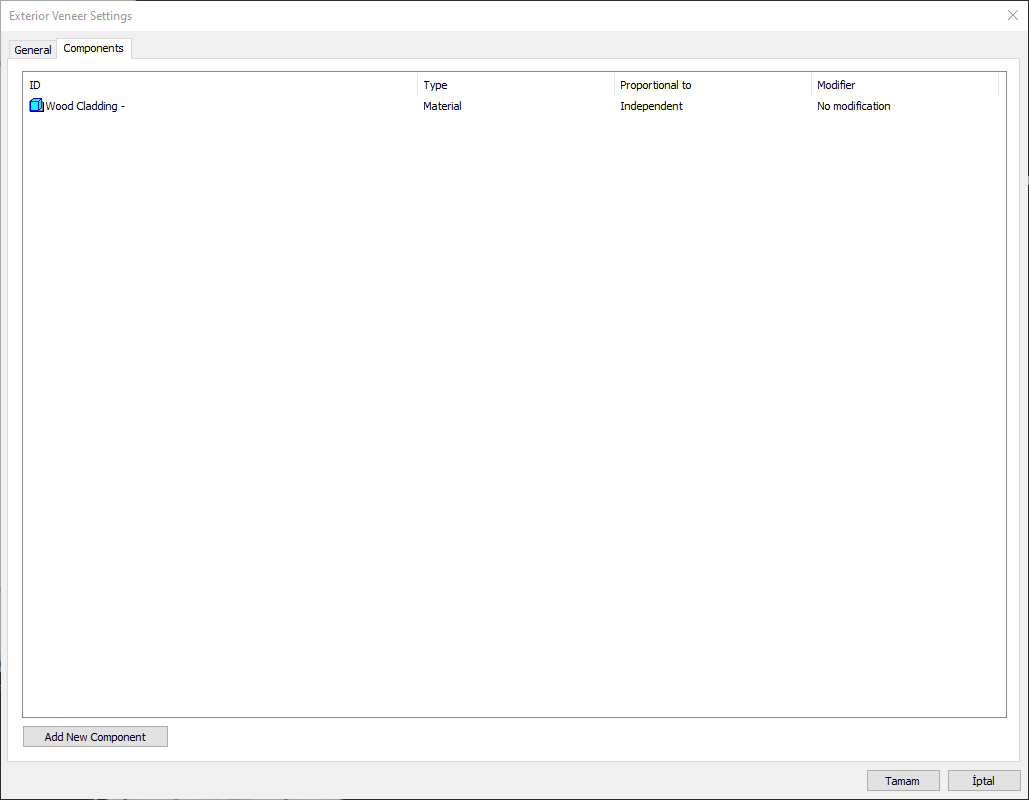
Add building components: Assigns the building materials defined for the detailed building components metering to the wall object.
Click the Add Building Component button.
The Component Selection dialog will open.
In this dialog, click the folder related to the material from the list on the left. Choose the material you want to use.
Set the parameters on the right.
Click the OK button. The "Component Selection" dialog will be closed. A summary line of the material will appear in the Building Components tab. More than one material assignment can be made to an object.

In the usage section
No modification: The amount of material to be assigned for the object in question is marked when it is desired to be used in the size that was previously specified in the material definition.
Percentage: This line is marked when it is desired to be used with the percentage of the amount previously determined in the material definition, as much as the value entered in the "Value 1" line in the same dialog. For example, if the material quantity is 70, if the line “Value 1” says 40, it means the material amount will be used up to 40 * 70%.
Override: This line is marked so that the quantity entered in the “Value 1” line in the same dialog will be used instead of the quantity previously determined in the material definition.
Multiplier: This line is marked in order to use the value found at the end of the multiplication of the value entered in the "Value 1" line in the same dialog with the amount previously determined in the material definition.
Fraction: This line is marked so that the amount determined in the material definition before will be used as the fraction value created by the values entered in the "Value 1" and "Value 2" lines in the same dialog. "Value 1" is the denominator "Value 2" is the denominator.
Proportional to: It is determined to what scale-area, circumference, length etc.-, region-side area, top, edge etc.- the material will be proportioned to. The content of the proportional list box is automatically determined according to the object and the size of the material. For example, a different list will be created if an operation is made for the column, a different list will be created for the library, a different list for the volume, and a different list for the field.
Following are the lines that appear in the proportion list according to the exterior veneer and material size.
Exterior Veneer | ||
Measure | Listed | Explanation |
Constant | Independent | It means that the length measure found while defining the material will be used exactly as the length value. |
Length | Independent | It means that the length measure found while defining the material will be used exactly as the length value. |
Length | It means that the length of the material will be found by multiplying the length measure found while defining the material by the element length. | |
Area | Independent | It means that the area measure found while defining the material will be used exactly as the amount. |
Outside area | It means that the area measure found while defining the material will be used by multiplying the element outside area. | |
Volume | Independent | The volume measure found when defining the material will be used exactly as the volume of the material. |
Volume | It means that the volume measure found when defining the material will be used by multiplying the volume of the element. | |
Count
| Independent | The number measure found while defining the material will be used exactly as the material number. |
Count | It means that the measure of number found when defining the material will be used by multiplying the number of elements. | |
